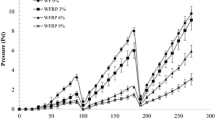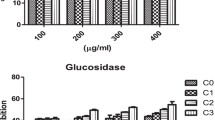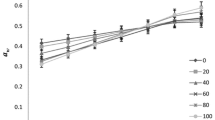Abstract
Brewers’ spent grain (BSG) is the major by-product of the brewing industry, with great potential as a functional ingredient due to its bioactive compounds. Thus, BSG could be suitable for improving the low nutritional quality of wheat-based snacks highly consumed by young people. The objective of this study was to substitute wheat flour with BSG (0, 10, 20, and 30%) for cookies elaboration, and evaluate the dough rheology, phenolic acids, antioxidant capacity, arabinoxylans content and proximate composition of the cookies Protein content and bioactive compounds (ferulic and p-coumaric acids, water unextractable arabinoxylans) of cookies significantly (p < 0.05) increased with the substitution level. In comparison to the wheat-alone cookies, the 20% BSG-containing cookies showed a lower hydrolysis and glycemic index (GI), and less total starch. The low cost, protein-rich BSG with antioxidant capacity improves the nutritional quality of cookies and may confer health benefits beyond basic nutrition.

Similar content being viewed by others
Abbreviations
- ABTS:
-
2,2′-azino-bis (3-ethylbenzothiazoline-6-sulphonic acid)
- AX:
-
Arabinoxylans
- BSG:
-
Brewers´ Spent Grain
- BU:
-
Brabender Units
- DS:
-
Digestible Starch
- DPPH:
-
2,2′-diphenyl-1-picrylhydrazyl
- GI:
-
Glycemic Index
- HI:
-
Hydrolysis Index
- RS:
-
Resistant Starch
- TS:
-
Total Starch
- WEAX:
-
Water Extractable Arabinoxylans
- WUAX:
-
Water Unextractable Arabinoxylans
References
Reis SF, Gullón B et al (2014) Evaluation of the prebiotic potential of arabinoxylans from brewer’s spent grain. Appl Microbiol Biotechnol 98(22):9365–9373
Bilgiçli N, İbanogˇlu Ş, Herken EN (2007) Effect of dietary fibre addition on the selected nutritional properties of cookies. J Food Eng 78:86–89
Zucco F, Borsuk Y, Arntfield SD (2011) Physical and nutritional evaluation of wheat cookies supplemented with pulse flours of different particle sizes. LWT-Food Sci Technol 44:2070–2076
Yousaf AA, Ahmed A et al (2013) Nutritional and functional evaluation of wheat flour cookies supplemented with gram flour. Int J Food Sci Nutr 64:63–68
Ganorkar PM, Jain RK (2014) Effect of flaxseed incorporation on physical, sensorial, textural and chemical attributes of cookies. Food Res Int 21:1515–1521
Mussatto SI, Dragone G, Roberto IC (2006) Brewers’ spent grain: generation, characteristics and potential applications. J Cereal Sci 43:1–14
McCarthy AL, O’Callaghan CY et al (2012) Phenolic extracts of brewers’ spent grain (BSG) as functional ingredients-assessment of their DNA protective effect against oxidant-induced DNA single strand breaks in U937 cells. Food Chem 134:641–646
McCarthy AL, O’Callaghan C et al (2013) Brewers’ spent grain; bioactivity of phenolic component, its role in animal nutrition and potential for incorporation in functional foods: a review. Proc Nutr Soc 72:117–125
Ingerslev AK, Theil PK et al (2014) Resistant starch and arabinoxylan augment SCFA absorption, but affect postprandial glucose and insulin responses differently. Br J Nutr 111:1564–1576
Øverby NC, Sonestedt E et al (2013) Dietary fiber and the glycemic index: a background paper for the nordic nutrition recommendations 2012. Food Nutr Res 57(1):20709
Öztürk S, Özboy Ö, Cavidoglu I, Köksel H (2002) Effects of brewer’s spent grain on the quality and dietary fibre content of cookies. J I Brewing 108:23–27
Petrović JS, Pajin BS et al (2017) Quality properties of cookies supplemented with fresh brewer's spent grain. Food and Feed Research 44(1):57–63
Okpala LC, Ofoedu PI (2018) Quality characteristics of cookies produced from sweet potato and wheat flour blend fortified with brewer’s spent grain flour. Curr Res Nutr Food Sci 6(1)
AACC International (2000) Approved Methods of the American Association of Cereal Chemists, 10th Ed. St. Paul, The Association
Brand-Williams W, Cuvelier ME, Berset C (1995) Use of a free radical method to evaluate antioxidant activity. LWT-Food Sci Technol 28:25–30
Malunga LN, Beta T (2015) Antioxidant capacity of water-extractable arabinoxylan from commercial barley, wheat, and wheat fractions. Cereal Chem 92(1):29–36
Guo W, Beta T (2013) Phenolic acid composition and antioxidant potential of insoluble and soluble dietary fibre extracts derived from select whole-grain cereals. Food Res Int 51:518–525
Pedrero DL, Pangborn RM (1989) Evaluación sensorial de los alimentos. Métodos analíticos. Editorial Alhambra Mexicana. D.F. México
Goñi I, Garcia-Alonso A, Saura-Calixto F (1997) A starch hydrolysis procedure to estimate glycemic index. Nutr Res 17(3):427–437
Santos M, Jiménez JJ, Bartolomé B et al (2003) Variability of brewer’s spent grain within a brewery. Food Chem 80:17–21
Kissel LT, Prentice N (1979) Protein and fiber enrichment of cookie flour with brewer’s spent grain. Cereal Chem 56(4):261–266
Bushuk, W (1998) Interaction in wheat doughs. In: Interactions: The keys to cereal quality, 1st edn. American Association of Cereal Chemists, Inc., St. Paul, Minnesota, pp 8–16
Goldstein S (1957) Sulfydryl- und disulfidgruppen der Klebereiweisse und ihre beziehung zur backfahigkeit der brotmehle. Mitt. Geb. Lebensmittel Unters Hyg 48:87–93
Ajanaku KO, Dawodu FA et al (2011) Functional and nutritional properties of spent grain enhanced cookies. Am J Food Technol 6(9):763–771
Sharif K, Butt MS, Huma N (2005) Oil extraction from rice industrial waste and its effect on physico-chemical characteristics of cookies. Nutrition Food Science 35(6):416–427
Sharma P, Gujral HS (2014) Cookie making behavior of wheat-barley flour blends and effects on antioxidant properties. LWT-Food Sci Technol 55:301–307
Adom KK, Liu RH (2002) Antioxidant activity of grains. J Agric Food Chem 50:6182–6187
Masisi K, Beta T, Moghadasian MH (2016) Antioxidant properties of diverse cereal grains: a review on in vitro and in vivo studies. Food Chem 196:90–97
Malunga LN, Izydorczyk M, Beta T (2017) Effect of water-extractable arabinoxylans from wheat aleurone and bran on lipid peroxidation and factors influencing their antioxidant capacity. Bioact Carbohydr Diet Fibre 10:20–26
Reis SF, Abu-Ghannam N (2014) Antioxidant capacity, arabinoxylans content and in vitro glycaemic index of cereal-based snacks incorporated with brewer's spent grain. LWT-Food Sci Technol 55(1):269–277
Costabile A, Klinder A, Fava F et al (2007) Whole-grain wheat breakfast cereal has a prebiotic effect on the human gut microbiota: a double-blind, placebo-controlled, crossover study. Br J Nutr 99:110–120
Ikuomola DS, Otutu OL, Oluniran DD (2017) Quality assessment of cookies produced from wheat flour and malted barley (Hordeum vulgare) bran blends. Cogent Food Agric 3(1):1293471
Reyes-Pérez F, Salazar-García MG et al (2013) Estimated glycemic index and dietary fiber content of cookies elaborated with extruded wheat bran. Plant Foods Hum Nutr 68:52–56
Lattimer JM, Haub MD (2010) Effects of dietary fiber and its components on metabolic health. Nutrients 2:1266–1289
Sajilata MG, Singhal RS, Kulkarni PR (2006) Resistant starch–a review. Compr Rev Food Sci Food Saf 5:1–17
Acknowledgements
The authors gratefully acknowledge María Teresa Zúñiga Ramos, Maribel Yael Valencia Tapia, Yésica Martínez Nuñez, as well as Cervecería Cuauhtémoc-Moctezuma, S. A. de C.V., Navojoa, Sonora, México.
Author information
Authors and Affiliations
Corresponding author
Ethics declarations
Conflict of Interest
The authors declare no conflict of interest in submission of this manuscript.
Additional information
Publisher’s Note
Springer Nature remains neutral with regard to jurisdictional claims in published maps and institutional affiliations.
Electronic Supplementary Material
ESM 1
(DOCX 60 kb)
Rights and permissions
About this article
Cite this article
Heredia-Sandoval, N.G., Granados-Nevárez, M., Calderón de la Barca, A.M. et al. Phenolic Acids, Antioxidant Capacity, and Estimated Glycemic Index of Cookies Added with Brewer’s Spent Grain. Plant Foods Hum Nutr 75, 41–47 (2020). https://doi.org/10.1007/s11130-019-00783-1
Published:
Issue Date:
DOI: https://doi.org/10.1007/s11130-019-00783-1




